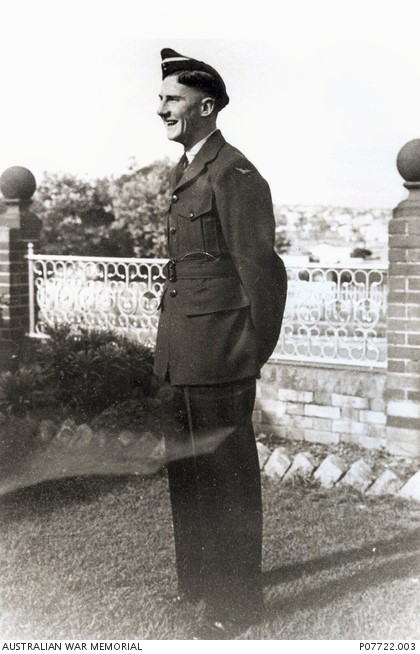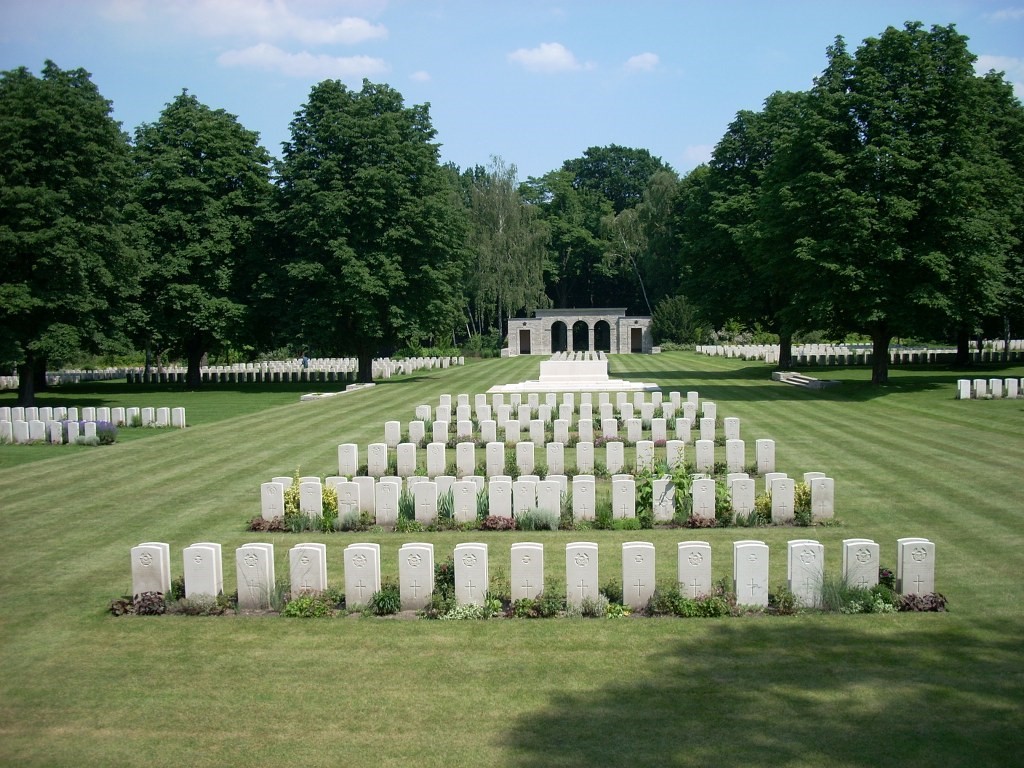Pilot Officer Kenneth Moreton (DFC), the son of Alexander Moreton and Jessie Lanchester Moreton (nee Gowing), was born at Sydney in New South Wales on 17th June 1921. He was educated at the Toowoomba Grammar School. After leaving school he became a School Teacher. He was enrolled in the Reserve of the Royal Australian Air Force on 4th January 1941 after swearing an oath of allegiance and issued with Reserve Badge No. 2543. At the age of 19 years and 9 months he was enlisted in the Citizen Air Force of the R.A.A.F. at No. 3 Recruiting Centre in Brisbane on 31st March 1941 after giving a commitment that he would serve for the duration of the war and an additional 12 months. At the time of enlistment he was unmarried and employed as a School Teacher. His physical description was that he was 5 feet 10 inches in height and weighed 140 pounds. He had a fair complexion, hazel eyes and brown hair. He stated that he was of the Presbyterian religion. He gave his next of kin as father, Mr Alexander Moreton, residing at 7 Allan Street, Toowoomba.
Pilot Officer Kenneth Moreton was allotted the service number of 405465. He joined No. 3 Initial Training School at Sandgate in Queensland on 31st March 1941. He joined No 1 Air Observation School at Cootamundra in New South Wales on 25th July 1941. He joined No. 1 Bombing & Gunnery School at Evans Head in New South Wales on 18th October 1941. After completing his training at Evans Head he qualified for the Air Observer Qualification Badge and was promoted to the rank of Temporary Sergeant on 8th January 1942. He joined No. 1 Air Navigation School at Parkes in New South Wales on 13th December 1941. He joined No. 2 Service Flying Training School at Forest Hill in New South Wales on 10th January 1942. He joined No. 5 Service Flying Training School at Uranquinty in New South Wales on 25th March 1942. He joined No. 3 Embarkation Depot at Sandgate in Queensland on 31st March 1942. He joined No. 2 Embarkation Depot at Bradfield Park in Sydney on 15th June 1942 to prepare for overseas service on attachment to the Royal Air Force. He was promoted to the rank of Temporary Flight Sergeant on 8th July 1942.
Pilot Officer Kenneth Moreton embarked from Sydney on 24th August 1942 and disembarked in England on 18th November 1942 where he joined No. 3 Personnel Despatch & Reception Centre later that day. He joined No. 2 (Observer) Advanced Flying Unit at Millom in Cumberland on 16th March 1943. He joined No. 14 Operational Training Unit at Royal Air Force Station Cottesmore on 20th April 1943. He was promoted to the rank of Temporary Warrant Officer on 8th July 1943. He was remustered as a Navigator on 14th July 1943. He joined No. 1654 Conversion Unit at Royal Air Force Station Wigsley on 14th July 1943. He joined No. 57 Squadron Royal Air Force at Royal Air Force Station East Kirkby for operational duty on 19th August 1943. He was appointed to the commissioned rank of Pilot Officer on 9th December 1943.
Pilot Officer Kenneth Moreton was the Navigator and crew member of a No. 57 Squadron Royal Air Force Lancaster JB 311 that was lost to enemy action at Berlin in Germany on 29th January 1944. It was his 21st air operation over Europe.
On the following day after his aircraft failed to return to its base, the Officer Commanding No. 57 Squadron wrote the following letter to Kenneth Moreton’s father:
Dear Mr Moreton, It is with profound regret that I write to confirm the cable you will have received from the Air Ministry informing you that your son, Warrant Officer Kenneth Moreton, is missing following operations on the night of 28th/29th January 1944. He was navigating an aircraft detailed to take part in a raid against Germany, but as it is usual for radio silence to be maintained after take-off, it has not been possible to determine the cause of its failure to return.
I held a very high opinion of your son. He was an extremely capable and experienced Navigator in whom his Captain and myself had every confidence. He would shortly have completed his first operational tour, having carried out many successful sorties against the enemy. I know the Captain, Pilot Officer K.C. McPhie, would have done everything possible to ensure the safety of his crew and there is, of course, every likelihood that they were able to abandon the aircraft and land safely in enemy territory. We all sincerely hope this was so, in which case news will ultimately reach you through the International Red Cross Committee. We can only hope and pray that they are safe and I wish to extend to you my own personal sympathy and that of all members of my Squadron during the anxious time you will have waiting for news. Any further official information concerning the missing aircraft or crew will be sent to you by the Air Ministry, but if, as sometimes happens, you receive news from outside sources, I shall be most grateful if you will let me know. If there is any way in which I can be of assistance to you in this distressing time, please do not hesitate to communicate with me. Yours sincerely C.H.W. Fisher, Wing Commander.
Subsequent information received from German sources by the International Red Cross revealed that two identified members of the Lancaster’s crew had lost their lives.
As a result of the wreckage of the Lancaster being located in the Russian zone and their refusal to allow British authorities to visit the scene, it was not until 7th March 1951 that Kenneth Moreton’s finally learned the fate of his son and the remainder of the crew of Lancaster JB 311 when the following letter was received from the Casualty Department:
Dear Sir, I refer to previous correspondence with regard to your late son, Pilot Officer Kenneth Moreton, D.F.C. The bodies of your son and all the other members of his crew have now been recovered from the Russian zone. The bodies had been buried by the Germans at Parchim which is about 24 miles south-east of Scherwin in northern Germany. The aircraft had crashed at the village of Glawe, near a lake called the Krakower See, about 20 miles north-east of Parchim and all members of the crew were killed instantly in the crash.
On exhumation it was only possible to determine the individual identities of Pilot Officer Andrews and Sergeants Reeves and Weston. Your son and Pilot Officers McPhie, Macmillan and Davis have therefore been laid to rest in a group of graves in the Berlin 1939-1945 War Cemetery. The crew is buried in Plot 2 Row H. The three identified members in graves 13, 14 and 15 respectively and graves 16, 17, 18 and 19, have been registered collectively for the other four including your son. The graves will be marked with permanent headstones and will be cared for in perpetuity by the Imperial War Graves Commission which is at present engaged in the beautification of the Cemetery. I hope this definite knowledge of your son’s fate and his last resting place will be of some comfort to you in your loss. Yours faithfully, M.C. Langslow.
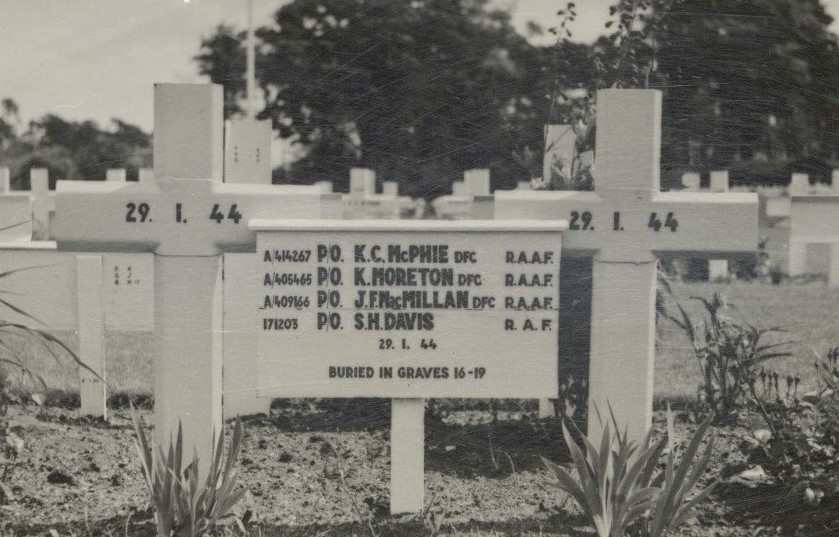
Temporary cross placed on the collective grave in the Berlin (1939-1945) War Cemetery
in which Kenneth Moreton’s remains were buried.
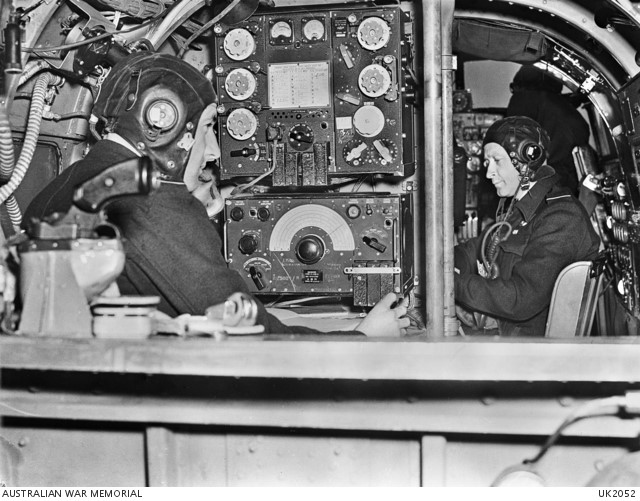
Australian War Memorial photograph UK2052
A Wireless Operator (left) and Navigator (left) in their positions inside a Lancaster.
Kenneth Moreton’s permanent headstone in the cemetery contains the family inscription “Greater Love Hath No Man”.
Kenneth Moreton was awarded a Distinguished Flying Cross on 28th January 1944 for his skill and courage on numerous operational missions. The citation for his award stated:
Warrant Officer Moreton has completed numerous operations against the enemy, in the course of which he has invariably displayed the utmost skill, courage and devotion to duty.
His award was presented to his father, Mr Alexander Moreton, at Parliament House, by the Governor of Queensland, on 8th March 1946.
Pilot Officer Kenneth Moreton, for his service during World War 2, was awarded the Navigator Qualification Badge, the Distinguished Flying Cross, the 1939/1945 Star, the Aircrew Europe Star, the Defence Medal, the War Medal, the General Service Medal and the Australian Service Medal 1939/1945.
Additional information
Pilot Officer Kenneth Moreton was killed during the 13th bombing raid during the “Battle of Berlin”. Alan W. Cooper’s book, “Bombers over Berlin – The R.A.F. Offensive November 1943 – March 1944”, is an excellent detailed history of the bombing of Berlin. It lists all of the aircraft lost and details of each aircraft’s crew and whether they were killed or became prisoners of war. It essential reading to fully appreciate what the bomber crews faced when attacking this formidable target.
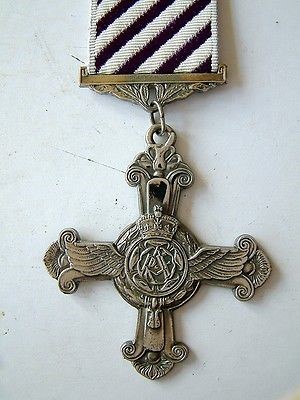
Kenneth Moreton was awarded a Distinguished Flying Cross on 28th January 1944 for his skill and courage on numerous operational missions. The citation for his award stated:
Warrant Officer Moreton has completed numerous operations against the enemy, in the course of which he has invariably displayed the utmost skill, courage and devotion to duty.
His award was presented to his father, Mr Alexander Moreton, at Parliament House, by the Governor of Queensland, on 8th March 1946.
Toowoomba Grammar School archive records show that he enrolled as a student on 1st January 1935 and left the school on 31st December 1936.


